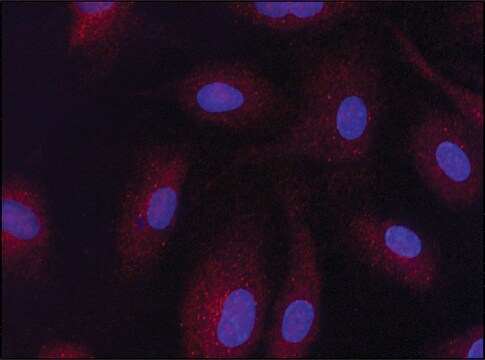05-777
Anti-Phosphotyrosine Antibody, recombinant clone 4G10®
clone 4G10®, Upstate®, from mouse
Sign Into View Organizational & Contract Pricing
All Photos(1)
About This Item
UNSPSC Code:
12352203
eCl@ss:
32160702
NACRES:
NA.41
Recommended Products
biological source
mouse
Quality Level
antibody form
purified immunoglobulin
antibody product type
primary antibodies
clone
4G10®, monoclonal
species reactivity
vertebrates
manufacturer/tradename
Upstate®
technique(s)
immunoprecipitation (IP): suitable
western blot: suitable
isotype
IgG2bκ
shipped in
wet ice
target post-translational modification
phosphorylation (pTyr)
General description
Some of the tyrosine residues can be tagged with a phosphate group (phosphorylated) by protein kinases. (In its phosphorylated state, it is referred to as phosphotyrosine.). Tyrosine phosphorylation is considered as one of the key steps in signal transduction and regulation of enzymatic activity. The advent of anti-phospho-tyrosine antibodies is one of significant events in signal transduction research. Before the availability of anti-phosphotyrosine antibodies, tyrosyl phospyhorylation of proteins and enzymes was investigated through hazardous and time-consuming radioactive experiments. Anti-phosphotyrosine antibodies are commonly used in western blots after the targeted proteins have been immunoprecipitated to measure the tyrosyl phosphorylation of the proteins. Anti-phosphotyrosine antibodies are also directly used on cell lysate to examine the overall change of tyrosine phosphorylation level in reponse to various treatments.
Immunogen
Produced from CHO cells expressing the 4G10 antibody heavy and light chain cDNAs. Heavy chain C-terminus has a hexa-histidine tag for purification and immobilization via Nickel affinity matrices.
Application
Anti-Phosphotyrosine Antibody, clone 4G10 is a recombinant antibody that detects tyrosine phosphorylated proteins in all species. This unique recombinant antibody is validated for use in IC, IH, IP, WB and is published in peer review journals.
Quality
routinely evaluated by immunoblot on a modified RIPA lysate from EGF-treated human A431 carcinoma cells
Target description
varies
Physical form
Format: Purified
Protein G purified recombinant 4G10 mouse IgG2bk in 0.01M Phosphate Buffer containing no preservative, pH 7.1
Analysis Note
Control
Positive Antigen Control: Catalog #12-302, EGF-stimulated A431 cell lysate. Add 2.5µL of 2-mercaptoethanol/100µL of lysate and boil for 5 minutes to reduce the preparation. Load 20µg of reduced lysate per lane for minigels.
Positive Antigen Control: Catalog #12-302, EGF-stimulated A431 cell lysate. Add 2.5µL of 2-mercaptoethanol/100µL of lysate and boil for 5 minutes to reduce the preparation. Load 20µg of reduced lysate per lane for minigels.
Legal Information
4G10 is a registered trademark of Upstate Group, Inc.
UPSTATE is a registered trademark of Merck KGaA, Darmstadt, Germany
Not finding the right product?
Try our Product Selector Tool.
recommended
Product No.
Description
Pricing
Storage Class Code
12 - Non Combustible Liquids
WGK
WGK 2
Flash Point(F)
Not applicable
Flash Point(C)
Not applicable
Certificates of Analysis (COA)
Search for Certificates of Analysis (COA) by entering the products Lot/Batch Number. Lot and Batch Numbers can be found on a product’s label following the words ‘Lot’ or ‘Batch’.
Already Own This Product?
Find documentation for the products that you have recently purchased in the Document Library.
Cytosolic lysine residues enhance anterograde transport and activation of the erythropoietin receptor.
Liron Yosha,Orly Ravid,Nathalie Ben-Califa,Drorit Neumann
The Biochemical Journal null
Kazunobu Tachibana et al.
Molecular and cellular biology, 25(11), 4693-4702 (2005-05-19)
The development of the cardiovascular system and the development of the early hematopoietic systems are closely related, and both require signaling through the Tie2 receptor tyrosine kinase. Although endothelial cells and hematopoietic cells as well as their precursors share common
Trond Methi et al.
European journal of immunology, 38(9), 2557-2563 (2008-09-16)
T cells with short interfering RNA-mediated Lck-knockdown (kd) display paradoxical hyper-responsiveness upon TCR ligation. We have previously reported a possible mechanism for T-cell activation in cells with low levels of Lck depending on Grb2-SOS1 recruitment to the zeta-chain of TCR/CD3
Takuwa Yasuda et al.
The Journal of clinical investigation, 126(6), 2064-2076 (2016-04-26)
Skin homeostasis is maintained by the continuous proliferation and differentiation of epidermal cells. The skin forms a strong but flexible barrier against microorganisms as well as physical and chemical insults; however, the physiological mechanisms that maintain this barrier are not
Sean Caenepeel et al.
Journal of experimental & clinical cancer research : CR, 29, 96-96 (2010-07-17)
Activating mutations in Kit receptor tyrosine kinase or the related platelet-derived growth factor receptor (PDGFR) play an important role in the pathogenesis of gastrointestinal stromal tumors (GIST). This study investigated the activity of motesanib, an inhibitor of vascular endothelial growth
Our team of scientists has experience in all areas of research including Life Science, Material Science, Chemical Synthesis, Chromatography, Analytical and many others.
Contact Technical Service







